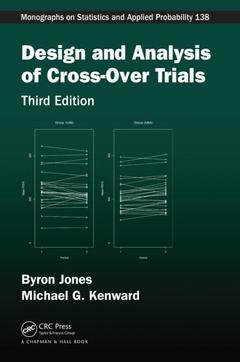Description
Design and Analysis of Cross-Over Trials (3rd Ed.)
Chapman & Hall/CRC Monographs on Statistics and Applied Probability Series
Authors: Jones Byron, Kenward Michael G.
Language: English
Subjects for Design and Analysis of Cross-Over Trials:
Keywords
WASO Time; Average Total Sample Size; interim; Sample Size Re-estimation; sequence; OLS Estimator; group; Interim Analysis; direct; Fixed Subject Effects; treatment; Data Set; effect; Toss Procedure; Random Subject Effects; hypothesis; Effect DF DF; bioequivalence; Direct Treatment Effect; studies; Yi Jk; Bioequivalence Study; Proc Glimmix; Estimate SE; Single Interim Analysis; Linear Mixed Models; Unblinded Interim Analysis; Sequence Groups; Balaam’s Design; AUC Cmax; Group Sequential Design; Proc Freq; Orthogonal Latin Squares; Recalculated Sample Size
129.87 €
In Print (Delivery period: 15 days).
Add to cart· 15.6x23.4 cm · Hardback
Description
/li>Contents
/li>Readership
/li>Biography
/li>
Design and Analysis of Cross-Over Trials is concerned with a specific kind of comparative trial known as the cross-over trial, in which subjects receive different sequences of treatments. Such trials are widely used in clinical and medical research, and in other diverse areas such as veterinary science, psychology, sports science, and agriculture.
The first edition of this book was the first to be wholly devoted to the subject. The second edition was revised to mirror growth and development in areas where the design remained in widespread use and new areas where it had grown in importance. This new Third Edition:
- Contains seven new chapters written in the form of short case studies that address re-estimating sample size when testing for average bioequivalence, fitting a nonlinear dose response function, estimating a dose to take forward from phase two to phase three, establishing proof of concept, and recalculating the sample size using conditional power
- Employs the R package Crossover, speciallycreated to accompany the book and provide a graphical user interface for locating designs in a large catalog and for searching for new designs
- Includes updates regarding the use of period baselines and the analysis of data from very small trials
- Reflects the availability of new procedures in SAS, particularly proc glimmix
- Presents the SAS procedure proc mcmc as an alternative to WinBUGS for Bayesian analysis
Complete with real data and downloadable SAS code, Design and Analysis of Cross-Over Trials, Third Edition provides a practical understanding of the latest methods along with the necessary tools for implementation.
Introduction. The 2×2 Cross-Over Trial. Higher-Order Designs for Two Treatments. Designing Cross-Over Trials. Analysis of Continuous Data. Analysis of Discrete Data. Bioequivalence Trials. Case Study: Phase I Dose–Response Noninferiority Trial. Case Study: Choosing a Dose–Response Model. Case Study: Conditional Power. Case Study: Proof of Concept Trial with Sample Size Re-Estimation. Case Study: Blinded Sample Size Re-Estimation in a Bioequivalence Study. Case Study: Unblinded Sample Size Re-Estimation in a Bioequivalence Study That Has a Group Sequential Design. Case Study: Various Methods for an Unblinded Sample Size Re-Estimation in a Bioequivalence Study. Appendix A: Least Squares Estimation. Bibliography.
Byron Jones is a senior biometrical fellow and executive director in the Statistical Methodology Group at Novartis Pharmaceuticals. Previously he was a senior statistical consultant/senior director at Pfizer and a senior director and UK head of the Research Statistics Unit at GlaxoSmithKline. In addition to 14 years of experience in the pharmaceutical industry, he has 25 years of experience in academia, ultimately holding the position of professor of medical statistics at De Montfort University. Currently he is an honorary professor at the London School of Hygiene and Tropical Medicine, visiting professor at University College London and at the University of Leicester, and a visiting professorial fellow at Queen Mary, University of London.
Michael G. Kenward is GlaxoSmithKline professor of biostatistics at the London School of Hygiene and Tropical Medicine. Previously he held positions at the Universities of Kent and Reading in the UK, and at research institutes in the UK, Iceland, and Finland. He has acted as a pharmaceutical industry consultant in biostatistics for more than 25 years. His research interests include the analysis of longitudinal data and cross-over trials, and modeling in biostatistics, with a particular interest in the problem of missing data. He has co-authored three textbooks and is well known for his 1994 Royal Statistical Society read paper on missing data.




